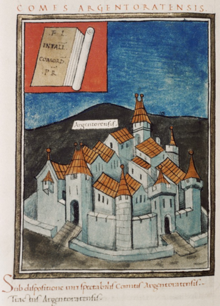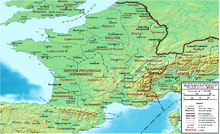Comes tractus Argentoratensis
The Comes tractus Argentoratensis (literally: "Count of the Strasbourg section") was in late antiquity the commander of mobile intervention troops of the western Roman army, which operated along the Upper Rhine border ( Danube-Iller-Rhine-Limes ), diocese of Gaul .
definition
The title Comes was usually given to members of the highest rank of the nobility (vir spectabilis) or the closest confidante of the emperor. In the late Roman army, he transferred himself to the commanders of the mobile field armies or officers who were entrusted with temporary special commands (Comes rei militaris) . His direct superior was the Magister peditum praesentalis of the West (OB of the Infantry). His responsibilities (tract) extended mainly to the region around the military camp Argentoratum (i. E., The current Strasbourg and Alsace ), in the province of Germania I .
development
Eugen Ewig is of the opinion that the units listed in the Notitia Dignitatum were stationed in the province of Germania I during the reorganization of the Rhine border by Valentinian I. 369/370 in the province. At that time, the district of Dux Germaniae primae could have been divided into two new military districts, that of Dux Mogontiacensis and the Comes Tractus Argentoratensis . The reason for this was internal power struggles among the neighboring Alemanni in the years between 354 and 379. The administration of the Mainz Dux was organized according to the guidelines introduced under the army master Stilicho . This could also mean that this reorganization was only implemented on his order in the years 396–398.
John Bagnell Bury suggested that the office (comitativa) was not held by Constantius III until the beginning of the fifth century . (from 413 at the latest), which was able to give the western empire a last respite before its dissolution with the stabilization of the Rhine border. The starting position for the defense of Gaul had changed fundamentally for the Romans after the devastating barbarian invasion in 406 . A large part of the Roman border guard units of Germania prima had either been destroyed or blown up by the invaders. Possibly the units of the Roman Rhine Army that were still capable of fighting could only hold their own in the larger cities or legion camps such as Argentoratum . The ranks of the Gallic field army were later replenished with limitanei (as pseudocomitatenses ) or Germanic federates due to lack of money . Constantius was forced to station mobile units for a long time at some border sections that had previously only been secured by the Limitanei . Probably the only way to quickly close the gaps in the Roman defense system. The Comes then took over, together with the Dux Mogontiacensis , the defense of the section of the Dux of Germania prima, either deposed or no longer able to act . The Strasbourg comitativa presumably existed until the Magister Galliarum was appointed .
According to Arnold HM Jones, the comitativa was set up in the time when the imperial rule on the Upper Rhine was limited to the Maxima Sequanorum after the barbarian invasion . Argentoratum was just a preferred outpost. The office was probably established shortly after Stilicho's death and abolished again after the establishment of the Comes Illyrici and the Magister Galliarum .
Written sources
The Strasbourg Comes is only known from the Notitia Dignitatum Occidentum . In the Notitia the area of responsibility of the Comes is not represented as several cities or forts , but symbolically as "Castrum Argentoratum". In contrast to the Duces , in the chapter of the Comes neither its administrative staff (officium) , troop units, their commanding officers, nor the fortress towns or forts in which they were stationed are given. It appears that it was inserted just before the last update of the Western Notitia. What speaks for an establishment of the office in the 5th century. It could also be an indication that his troops were an integral part of the Magister peditum's army and were therefore also administered by his administrative staff. The Comes and the indication of its area of responsibility also appear in the chapter of the Magister peditum .
troops
Which units the Comes had under his command is unknown due to the lack of relevant written sources. Part of the Legio VIII Augusta was certainly still in Strasbourg towards the end of the 3rd century. The camp garrison was probably directly subordinate to him. Their presence can be proven by brick stamps up to the early 4th century. Their further fate after the middle of the 4th century is unclear. In the Notitia Dignitatum only one vexillation , the Octavani , appears from her, transferred to the field army in the early 4th century . A Valentinian building inscription from the Upper Rhine names the building crew of a leg (io) octa (va) [August?] Anensium ; here it is not certain whether this refers to the troops of the field army or the garrison of the Strasbourg camp - which in the latter case indicates their continued existence beyond the middle of the 4th century. Since the 4th century individual vexillations a . a. also been distributed to warehouses on the Lower Rhine, in Switzerland and in Italy. Most of the other units of the Comes were stationed in forts in the immediate vicinity of the legionary camp (e.g. in Brumath, Zabern , Saarburg, Breisach ). Like the Comes Italiae , the Comes Illyrici and the Comes Britanniarum , in his section he probably only commanded units of the mobile field army ( Comitatenses ) . In the 5th century, the troops of the Dux of the Sequania province were also under his control .
The crescent-shaped emblems on the painted shield of the Octavani are reminiscent of lawn cutters (the Latin name is unknown) that were used by the legionnaires when building camps. One specimen has been excavated in Newstead, Scotland. But it could also be pelte-shaped decorative elements , which can often be seen in different variations on Tabula ansata 's . Such tabula ansata have been painted on shields since the Principate in order to be able to identify the unity, but also as an ornament, as several metopes at the Tropaeum Traiani in Adamclisi in Romania prove. It is therefore possible that the painted shields of the Octavani go back to such decorative elements . A similar motif can be seen on a shield that is carried by one of the soldiers on the so-called Brescia casket, an ivory box from the 4th century.
See also
List of forts in the Danube-Iller-Rhein-Limes
References and comments
- ↑ Eugen Ewig, 1979, pp. 272-273
- ↑ JBBury: 1920, pp. 144 and 151, Ralf Scharf: 2005, pp. 301 and 304.
- ↑ AHM Jones, 1986, p. 1424
- ↑ ND occ. XXVII, ("at the disposal of the most honorable Count of the Strasbourg section"). Sub dispositione viri spectabilis comitis Argentorensis: Tractus Argentoratensis .
- ↑ AHM Jones, 1986, p. 1424, Ralf Scharf, 2005, p. 301 and 302 / note 19, ND-Occ. V, VI.
- ↑ z. B. on the construction of watchtowers at DIRL near Etzgen , CH, see also the Valentine inscription CIL 13, 11538
- ↑ ND.occ. 5, 153 = 7, 28, Ralf Scharf: 2005, p. 301, note 34., Michaela Konrad, Christian Witschel 2011, p. 12, see also Brescia Casket in en.Wikipedia.
literature
- John Bagnell Bury: The Notitia Dignitatum , The Journal of Roman Studies, Vol. 10, Society for the Promotion of Roman Studies, London 1922, pp. 131–154.
- AHM Jones : The Later Roman Empire. 284-602. A Social, Economic and Administrative Survey. Volume 2. Reprinted edition. Johns Hopkins University Press, Baltimore MD 1986, ISBN 0-8018-3354-X .
- Ralf Scharf: The Dux Mogontiacensis and the Notitia Dignitatum. A study of late antique border defense . Walter de Gruyter, Berlin et al. 2005, ISBN 3-11-018835-X ( Reallexikon der Germanischen Altertumskunde . Supplementary volumes, Volume 48. Limited preview in the Google book search).
- Eugen Ewig: The space between Selz and Andernach from the 5th to the 7th century , In: From late antiquity to the early Middle Ages: current problems in a historical and archaeological perspective, Thorbecke Verlag, Sigmaringen 1979, pp. 271–296.
- Michaela Konrad, Christian Witschel: Late antiquity legion camps in the Rhine and Danube provinces of the Roman Empire. A contribution to the continuity debate . In: Michaela Konrad, Christian Witschel (eds.): Roman legionary camps in the Rhine and Danube provinces - nuclei of late antique-early medieval life? . Beck, Munich 2011, ISBN 978-3-7696-0126-8 .
- Michael S. DuBois: Auxillae: A Compendium of Non-Legionary Units of the Roman Empire. Lulu Press 2015, ISBN 978-1-329-63758-0 .






